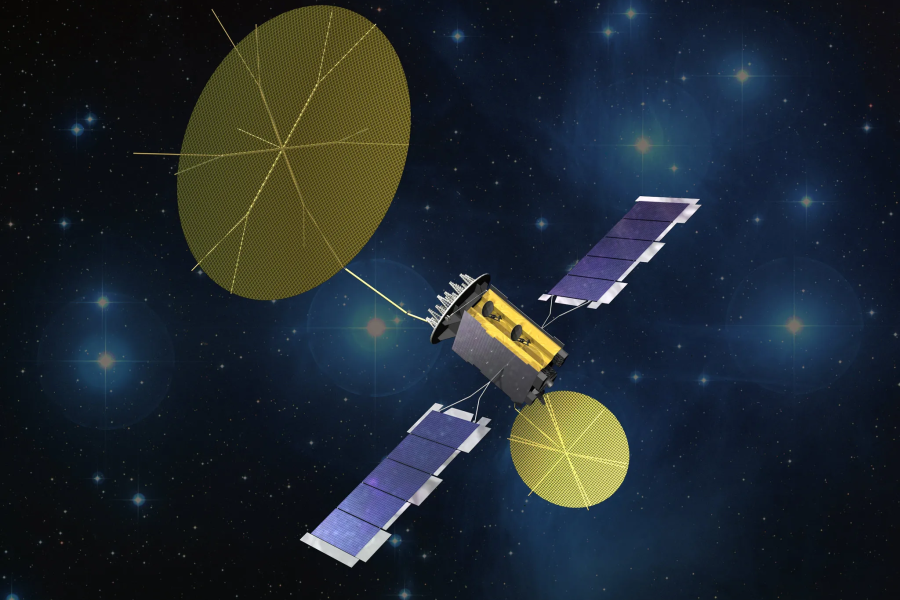Medium-Earth orbit—the region in space from 2,000 to 35,786 kilometers above the Earth’s surface—is getting more attention from the Space Force, potentially to host its next generation of narrowband communications satellites, part of a broader contemplation on the future of its entire satellite communications enterprise.
Space Systems Command published a request for information May 29 seeking plans and ideas for how to transition at least part of its narrowband SATCOM architecture to MEO, which it considers a “key aspect of the transition to the future.”
Today’s primary narrowband constellation is the Mobile User Objective System, which will add two more satellites in geostationary orbit in 2031 as part of a service life extension that will keep the six-satellite fleet operational until 2040. The MEO constellation USSF is envisioning would not deploy until near that time. The RFI details “delivery in 2031.”
GPS satellites operate in MEO today, but not much else. But the Space Force sees medium-Earth orbit as a way to bolster its narrowband capabilities.
“The Government is developing a vision for a future [narrowband] architecture which will likely entail multiple orbit regimes for delivery of advanced services to current and future user communities,” the request states. “Additional goals are increased resilience, reduced lifecycle cost, and decreased time scales for fielding new capabilities.”
Compared to wideband communications, narrowband signals are less complex and power-intensive. They can better penetrate bad weather and other obstacles, albeit with lower data rates.
The Navy developed MUOS and other narrowband satellites, but the Space Force assumed control of them in 2022 as it consolidated all satellite communications across the military.
Shortly after assuming responsibility, USSF kicked off the MUOS service life extension program, and in January awarded two $66 million contracts to Lockheed Martin and Boeing to design two new MUOS satellites. According to budget documents, the service plans to make a final selection in fiscal 2026.
That program will drive a surge in spending, with narrowband SATCOM investment rising from $228.4 million in 2025 to $706.2 million in 2028. All told, the service projects to spend $2.7 billion through the end of the decade, with still more investment after that.
The request for information does not specify how many spacecraft the Space Force is considering or how much it might be willing to spend on such a program. It does say, however, that it wants the satellites to be able to work with MUOS and other SATCOM constellations, and asks industry to provide input on the technical challenges and risks associated with delivering such a capability by 2031.
The Space Force is also eyeing commercial capabilities to supplement its narrowband satellites. In January, Breaking Defense reported that SSC was working on a long-term acquisition plan for narrowband, with commercial being one of the top options under consideration. The 2025 budget request seeks $134.5 million for Commercial Satellite Communications, or COMSATCOM, specifically to experiment with services using wideband, narrowband, protected, and commercial communications bands.
Specifically, the program is aimed at showing “the onboarding of MEO commercial SATCOM services into the SATCOM architecture,” according to budget documents.
The idea of placing more satellites into medium-Earth orbit has gained popularity in recent years, as an attractive middle ground between “big, fat juicy targets” in GEO and the mega-constellations now operating in LEO. With fewer than 200 satellites in medium-Earth orbit, compared to thousands in low-Earth orbit, the region is also less congested than even geostationary orbit, where several hundred satellites now orbit the Earth.
In addition to GPS and SATCOM, the Space Force is also working on missile warning/missile tracking satellites in MEO, part of an integrated system with the Space Development Agency’s low-Earth orbit constellation and the Next-Generation Overhead Persistent Infrared (OPIR) system and Space Based Infrared System (SBIRS) operating in geostationary orbit.
